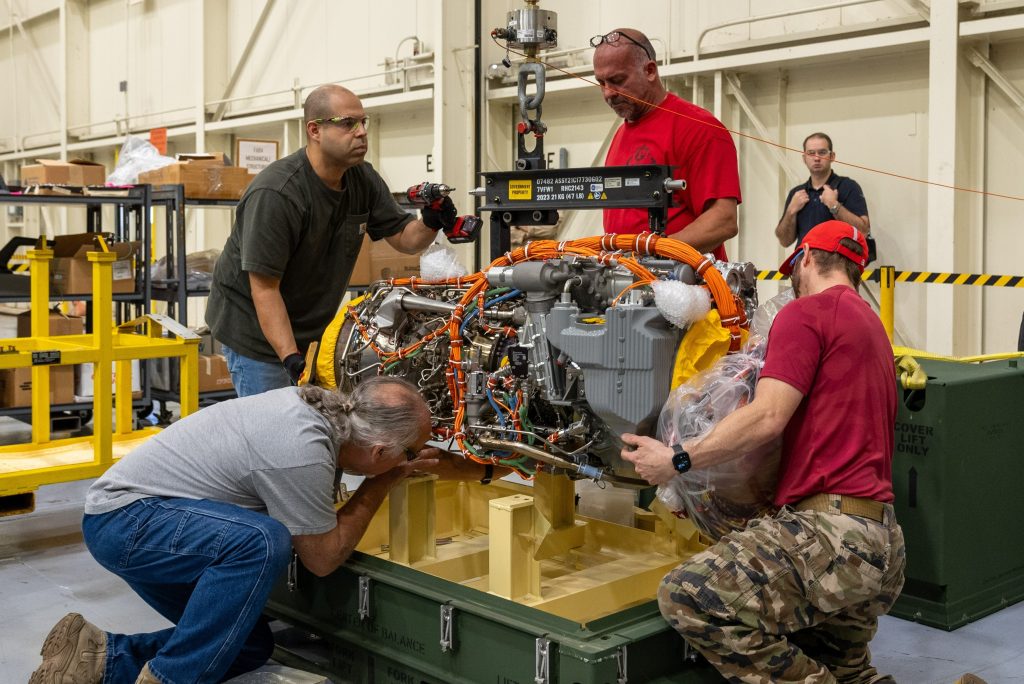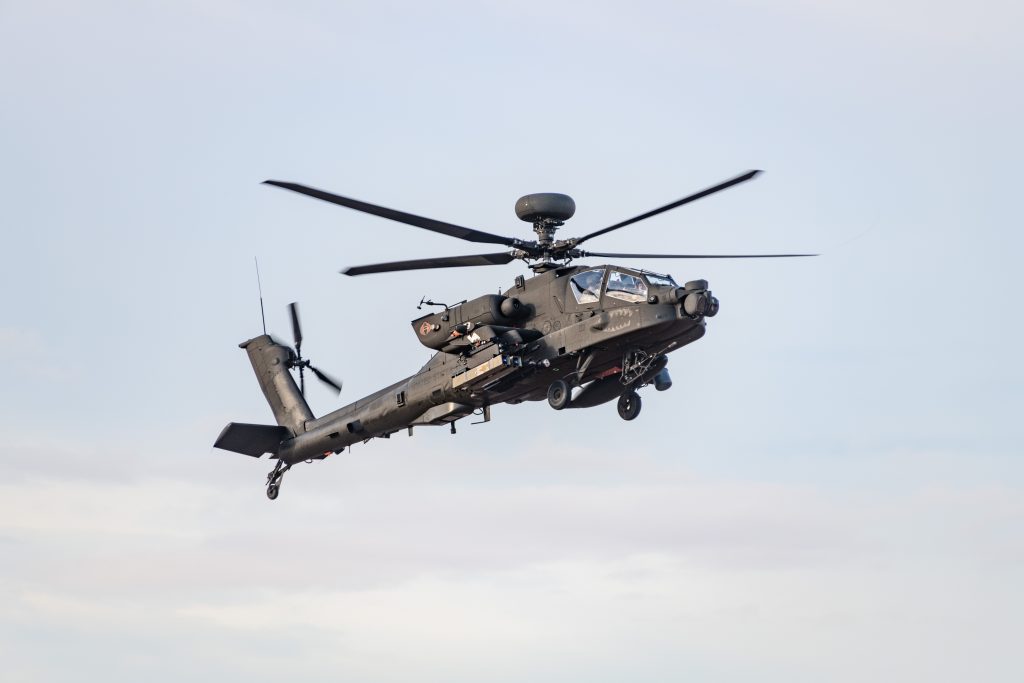
BLUE SKIES AHEAD: The ITE program will help reduce greenhouse gas emissions—the T901 saves 45,000 pounds of greenhouse gas emissions annually per aircraft. (Photo by Oleksandr P, Pexels)
The Improved Turbine Engine supports the Army Climate Strategy.
by Gina Bublitz and Caroline Lumb
The Army’s Improved Turbine Engine (ITE) supports the Army Climate Strategy by increasing operational capability while reducing greenhouse gas emissions. The strategy is the Army’s framework for mitigating the force’s effects on climate change. The ITE will provide Army aviation the power to operate in multidomain operations, with longer ranges for improved reach and heavier payloads to mass combat power quicker, while improving lethality and supporting the Army Climate Strategy’s objective of reducing the force’s overall greenhouse gas emissions.
The ITE, also known as the T901-GE-900 (T901), is the Army’s new 3,000 shaft horsepower engine designed to fit within the current engine footprint of the AH-64 Apache and the UH-60 Black Hawk helicopters. The T901 will replace both aircrafts’ current GE T700 engines.
INCREASED MULTIDOMAIN REACH AND LETHALITY
The T901 holistically combines additive manufacturing and traditionally machined parts to produce an engine that, despite using less fuel, is 50% more powerful than its predecessor, the T700. The T901 more than doubles the Apache and Black Hawk platforms’ mission payload while operating at 6,000 feet/95-degrees Fahrenheit, dramatically improving the ground commander’s reach and lethality across the battlefield. The AH-64 Apache and UH-60 Black Hawk will be able to meet mission objectives faster, with fewer aircraft, and spend more time on station with less fuel. This reduces dependence on forward arming and refueling points—temporary areas established close to combat zones used to provide fuel and ammunition necessary for aviation units to remain close to the fight—and their requisite logistics and security requirements. The cumulative benefits of the reduced fuel consumption and enhanced performance range of the T901 will allow a company air assault to be executed in a single lift (which eliminates refueling and multiple flights), thereby completing the mission in half the time while using less fuel compared with the T700.

NEW AND IMPROVED: Team members remove a recently delivered T901 engine from its shipping crate in West Palm Beach, Florida. (Photo by David Hylton, Program Executive Office, Aviation)
REDUCED LOGISTICAL BURDEN
The Army’s T901 engine further supports the ACS by utilizing advanced technology to reduce sustainment demand. The advanced engine employs predictive logistics, which offers future interoperability with Prognostic and Predictive Maintenance (PPMx), a set of linked components that provide self-diagnosis and automated maintenance alerts. T901 technological capabilities minimize acquisition and logistics footprints by using advanced diagnostics, system prognostics and health management to implement Condition-Based Maintenance Plus (maintenance performed based on evidence of need) and Item Unique Identifier (unique identifier that applies to a single item) marking requirements and initiatives. The ability to share usage, health and maintenance data across the network with the aviation enterprise is a crucial step in fleet management that is made possible by employing PPMx.
The Engine Health Monitoring System on each engine provides an accurate assessment of the engine’s gas path health and rotor life consumed. The indicated condition prompts maintenance efforts rather than relying on gross indicators such as operating hours, cycles or calendar time. The need-based maintenance model reduces maintenance and sustainment demand and creates less waste than performing maintenance based on gross indicators. Metrics from necessary maintenance also contribute to and improve reliability, availability and maintainability data. Logistics product data will become more accurate as well because there will be a better understanding of spares needed, how often they are needed, and what costs there will be due to those needs.
Additionally, the T901 utilizes advanced coatings for erosion resistance and thermal barriers. It incorporates key technologies such as ceramic matrix composites to increase engine durability and reduce engine weight. By extending time between overhauls, the T901 can reduce maintenance costs by up to 35%. Utilizing advanced technologies is just one of many ways the Army is modernizing to further advance the ACS mission of supporting the nation’s climate change goals and addressing national security threats.
GREENHOUSE GAS EMISSIONS REDUCTION
Besides significant operational and sustainment benefits, the ITE program supports the Army Climate Strategy by reducing greenhouse gas emissions. Greenhouse gases consist of harmful manmade and natural emissions that trap heat in the atmosphere. According to the strategy, climate change is a direct threat to U.S. security and the Army must work proactively to reduce associated risks. Each aircraft equipped with the T901 saves 45,000 pounds of greenhouse gas emissions annually. In total, Army aviation will reduce greenhouse gas emissions by 133.6 million pounds annually once all Apache and Black Hawk aircrafts are equipped with the T901. ITE supports the Army Climate Strategy mission through “more effective power solutions” and “advancements in manufacturing” to increase combat effectiveness and reduce greenhouse gas emissions.

ABOVE AND BEYOND: The T901 engine, designed to fit within the current engine footprint of the AH-64 Apache, combines additive manufacturing and traditionally machined parts to produce an engine that is 50% more powerful than the T700—dramatically improving the ground commander’s reach and lethality across the battlefield. (Photo courtesy of U.S. Army Yuma Proving Ground)
CONCLUSION
The Army will reduce the force’s overall contributions to climate change by implementing the ACS’s lines of effort. The T901 engine is a modernized combat multiplier that will increase Army aviation capabilities by boosting multidomain reach and lethality. It will better support the warfighter by providing increased reliability and sustainability for the AH-64 Apache and the UH-60 Black Hawk. The T901 engine accomplishes this while also supporting the Army Climate Strategy’s objective of reducing greenhouse gas emissions.
For more information, go to https://www.army.mil/PEOAviation.
GINA BUBLITZ is the Aviation Turbine Engines project manager within the Program Executive Office for Aviation, Redstone Arsenal, Alabama. She holds an M.S. in program management from the Naval Postgraduate School and a B.A. from George Mason University.
CAROLINE LUMB is an Avion Solutions Inc. employee supporting the Aviation Turbine Engines Project Office for strategic communications. She holds a B.S. in marketing from Auburn University.







